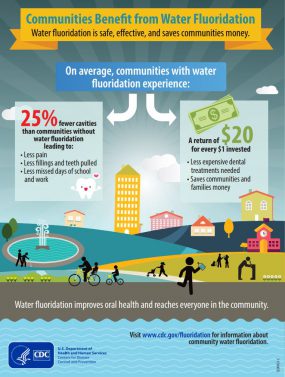Water fluoridation now accessible for small water systems
March 18, 2021 – A Centers for Disease Control and Prevention (CDC) funded research initiative offers access to optimally fluoridated water for up to 19 million people in the U.S. for the first time.
The new fluoridation method is designed to dissolve in a small amount of water, much like the chlorine tablets used in swimming pools. This tablet system could allow nearly 32,000 small public utilities – often in underserved, rural areas – to contribute to the national Healthy People goal of providing access to fluoridated water to 77.1% of the U.S. population by 2030.
Drinking fluoridated water has greatly improved oral health outcomes for over 75 years, keeping teeth strong and reducing cavities by about 25% in children and adults. Oral health is critical to overall health, yet oral diseases – ranging from cavities and gum disease to oral cancer – cause significant pain and infections across the globe. Untreated oral diseases can lead to problems eating, speaking, and learning. Over $45 billion is lost in productivity in the United States each year because of untreated oral disease.
“Drinking fluoridated water keeps teeth strong and reduces cavities, resulting in less pain, fewer fillings or teeth pulled, and fewer missed days of work and school,” said Karen Hacker, MD, MPH, Director of CDC’s National Center for Chronic Disease Prevention and Health Promotion. “As we honor World Oral Health Day on March 20, I am proud we could for the first time, make available such an important prevention strategy to so many people.”
Oral Disease Highlights Inequities
The burden of oral diseases highlights disparities in access to dental care and preventive services. In the U.S., children and adults from low-income households are two to three times more likely to have untreated cavities compared to those from higher-income households. Community water fluoridation is the most efficient and cost-effective way to deliver fluoride to everyone in a community, regardless of their age, income, or education.
About 35% of people in the U.S. – and most people around the world – do not have access to properly fluoridated water, often because they live in a home not served by a public water system or because their public water system lacks resources to install and maintain cost-effective fluoridation systems.
CDC Identifies Need for New Technology to Reach Rural Areas
The CDC recognized some smaller public water systems would need an alternative approach to optimally fluoridate water. In 2013, CDC announced a Small Business Innovation Research (SBIR) funding opportunity to develop a method similar to chlorine tablets used in swimming pools, so small systems could provide fluoridated water to their customers. Through a competitive, objective process, KC Industries (KCI) of Mulberry, Florida, received a CDC Phase I SBIR award in 2014 to test the idea.
Following successful competition for Phase 2 funding, the awardee created a tablet and feeder system that is economical for systems that serve between 50 and 10,000 people. Nearly 19 million people in the United States are served by these small systems — often in rural areas with less access to school dental sealant programs, healthy foods, and public transportation to get to dental appointments.
*Original press release online at https://www.cdc.gov/media/releases/2021/p0318-Fluoridation.html
** Also online at https://yubanet.com/scitech/cdc-initiative-creates-new-water-fluoridation-technology-to-support-rural-health-needs/

